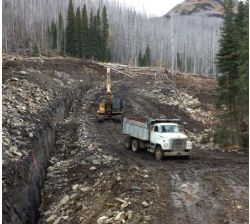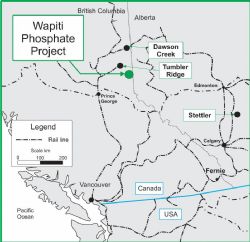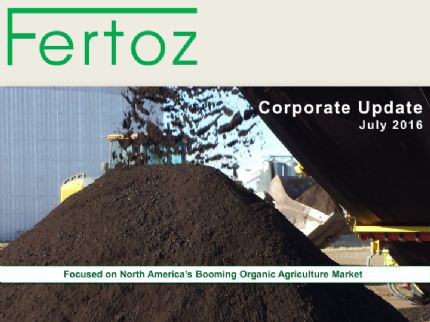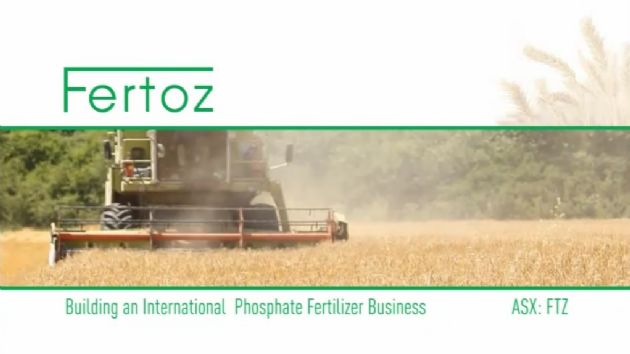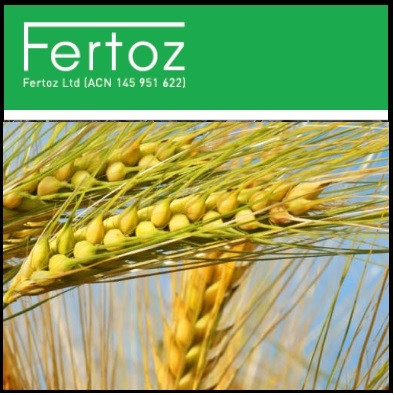
Wapiti phosphate Scoping Study Delivers 82% IRR
Perth, May 14, 2015 AEST (ABN Newswire) - Fertoz Limited ( ASX:FTZ) ("Fertoz" or the "Company") is pleased to announce a Scoping Study for a small-scale rock phosphate mine at the Company's 100%-owned Wapiti project in British Columbia.
ASX:FTZ) ("Fertoz" or the "Company") is pleased to announce a Scoping Study for a small-scale rock phosphate mine at the Company's 100%-owned Wapiti project in British Columbia.
Wapiti is located close to the mining town of Tumbler Ridge, is well supported by regional infrastructure and proximal to agricultural areas which utilise phosphate fertiliser.
The Scoping Study presents attractive development economics with capital expenditure of C$2.7m required to generate a project NPV of C$20.1m. The capital expenditure will be phased across three years; C$0.2m in 2015, C$1.5m in 2016 and C$1.0m in 2017. The C$/A$ rate as of 13 May 2015 is 1.04. Refer to Table 1 in link below for the key assumptions and financial metrics.
Managing Director Les Szonyi said: "The Scoping Study has been specifically designed to minimise upfront capital expenditure and achieve near term positive cash flow with a shallow, 7m deep open pit design for the initial 7 years of the project. With fertiliser sales well underway through our FertAg JV in Australia and the likelihood of near term commercial production in North America, Fertoz continues to establish its credentials as an emerging agribusiness."
The Scoping Study is based on a staged open pit development and the recently upgraded Wapiti resource (refer to ASX announcement "Fertoz upgrades Wapiti phosphate resource" released 12 May 2015.) The Scoping Study includes 3 stages in the proposed design, with an initial 7m open pit for the first 7 years of the project at an average strip ratio of 1.6:1. The Scoping Study conservatively assumes a 75ktpa production rate is reached in 2018, though it is probable this could be brought forward to 2017. The planned mine area contains a low risk resource which is outcropping, homogenous, and has been drilled and bulk sampled by Fertoz.
Mining
The mineralisation at Wapiti is steeply dipping to sub vertical and extends over an estimated strike of up to 39km in length. The relative uniformity and narrow nature of the deposit means that mining will be of a narrow-slot trenching style from the surface. The trench will progress down in slots (benches) with the first bench 1m below the surface. This method allows the first 6 years of production at Wapiti to be completed at less than a 1.6:1 strip ratio which greatly benefits free cash flow. After mining, excavated areas are backfilled and the area is subject to reclamation. This process has been optimised during the previous bulk sample extraction (Figure 1 in link below), where Fertoz gained significant experience in local conditions and expected performance of the extraction process for full scale mining.
Mining is planned to take place on a seasonal basis between May and October to maximise productivity and ease of access. Mined material will be transported, stockpiled and sold after it is processed to meet various market requirements. Current permits exist for 17.5ktpa of phosphate rock production and additional permit applications have been submitted to increase production to 75ktpa. It is expected that this amount could be produced and transported off-site within a 5 to 6 month period. To date, Fertoz has mined approximately 2.7kt of rock phosphate for processing and sale from both the Wapiti and Fernie projects. The Scoping Study has been completed on the basis of 75ktpa rock phosphate mined and sold. Whilst there is a compelling economic case for development based on this level of production, there are possibilities to expand production levels beyond 75ktpa thereby enhancing economic outcomes.
Infrastructure
The Wapiti project is located 850km north east of Vancouver, British Columbia (BC), 145km north east of Prince George, 70km south east of Tumbler Ridge (coal mining town) and 180km south east of the rail hub at Dawson Creek (Figure 2 in link below).
Ready access to the Wapiti site is possible via a number of public roads. These are suitable for the transport of heavy equipment and haulage of excavated material. A number of existing trails and roads exist on the Wapiti property. Several of these roads require an extension to facilitate the bulk sampling activities and to support ongoing operations.
In September 2014, a Notice of Work was submitted to construct a new access road which will allow phosphate rock to be transported from site using highway-registered trucks, most likely of B-Train capacity (36-40t).
The operation requires a limited amount of on-site infrastructure to be developed and used to support extraction operations of the bulk sample. Such infrastructure includes, but is not limited to:
- Feed stockpile;
- Overburden stockpile;
- Staging stockpile;
- Haul roads; and
- Camp accommodation.
Production would commence on a reduced scale with 30kt in 2016, 50kt in 2017 and rising to full production in 2018.
Margins per tonne sold are estimated at C$81/t (32% of sales price) for the first 7 years of production.
Processing
After mining on site, pre-crushed material is transported as broken rock to a manufacturing facility that will be established close to existing infrastructure. At this facility, rock is crushed to reduce the phosphate rock from 40mm (crushed rock) to approximately 0.15mm (ground material). Initial processing of bulk samples is planned to be conducted at Stettler where 1kt of rock phosphate from Fernie is currently stored. A Raymond mill will be purchased to grind the 40mm rock down to 0.15mm. Stettler (Figure 2 in link below) is the centre of a major farming area in Alberta. There is a further 9kt of bulk sample available for collection at Fernie for processing at Stettler.
The Scoping Study assumes that the Raymond mill will be moved to Dawson Creek (Figure 2) in 2016 (118km from Tumbler Ridge) where production from Wapiti East will begin. Dawson Creek has the advantage of being a proximal rail hub to Edmonton, Calgary, Prince George and Vancouver. It also has a trained workforce, industrial facilities, spare parts and industrial land.
The crushed rock phosphate from the Wapiti mine will be transported by road to the Raymond mill at Dawson Creek. From here, the product can be trucked or railed to customers (farmers and other third party fertiliser manufacturers).
Once the Raymond mill has been moved to Dawson Creek, additional processing equipment can be installed at Stettler to process the 0.15mm rock phosphate railed from Dawson Creek into other phosphate products. With this machinery in place at Stettler, the Company could provide ground rock phosphate for sale to farmers in the local area and other fertiliser processing companies, and also a more conventional fertiliser N-P-K mix.
There is potential for a separate processing facility at Fernie however this is not addressed in this Scoping Study.
Permitting and timetable
Fertoz currently has permits to extract 17.5ktpa of rock phosphate at Wapiti. In November 2014, the Company submitted a Small Mine Application to the British Columbia Ministry of Mines to extract up to 75ktpa of phosphate rock from its Wapiti project.
The Company is expecting to receive approval for its Small Mine Application at Wapiti in 2015. The next steps in the process are to:
a) Complete a survey of the mine lease - target date June 2015; and
b) Complete benefits agreement with the First Nations - target date August 2015
Discussions are continuing with the First Nations as part of the mine approval process.
The fertiliser season in Canada typically runs from April to September while the best time to mine product at Wapiti is from May to October. The Scoping Study assumes that 10kt of phosphate rock will be sold in 2016 and 30kt of phosphate rock inventory is built up in 2016 for processing and sale from April to June of 2017.
The proposed timetable for the Wapiti development is shown in Figure 3. A key focus of the timetable was to minimise costs in 2015 by collecting the remaining 9kt bulk sample from Fernie and processing it at Stettler using contractors. Sales from the total 10kt Fernie bulk sample are expected to be realised at the start of 2016 generating C$1.8m in revenue for Fertoz. Major processing equipment purchases are not required until 2017 when the production ramp-up to 75ktpa is planned.
For detailed capital costs, pricing and analysis, please visit:
http://media.abnnewswire.net/media/en/docs/ASX-FTZ-857685.pdf
About Fertoz Ltd
 Fertoz (ASX:FTZ) is an Australian-based phosphate exploration and development company with a range of projects in British Columbia, Canada as well as Queensland and the Northern Territory. The Company is focused on becoming a fertiliser producer as quickly as possible, initially focusing on the Canadian/USA markets.
Fertoz (ASX:FTZ) is an Australian-based phosphate exploration and development company with a range of projects in British Columbia, Canada as well as Queensland and the Northern Territory. The Company is focused on becoming a fertiliser producer as quickly as possible, initially focusing on the Canadian/USA markets.
Fertoz plans to develop its exploration assets in Canada in order to identify any potential Direct Shipping Ore (DSO) projects. It intends to seek joint venture partners to assist in funding the exploration projects in Australia.
Phosphate is a commodity necessary for feeding the world, and Fertoz is ready to capitalise on this growing demand.
| ||
|



